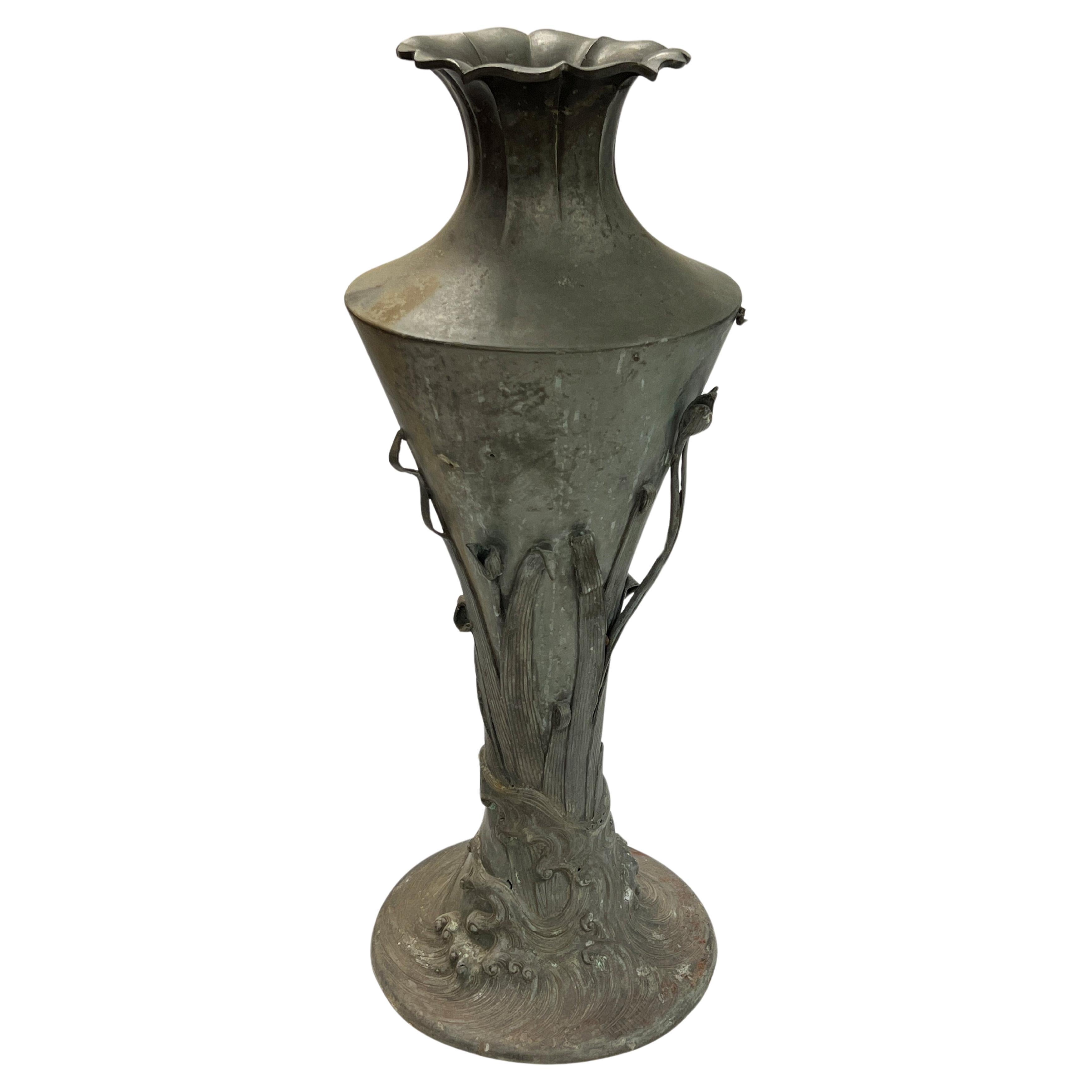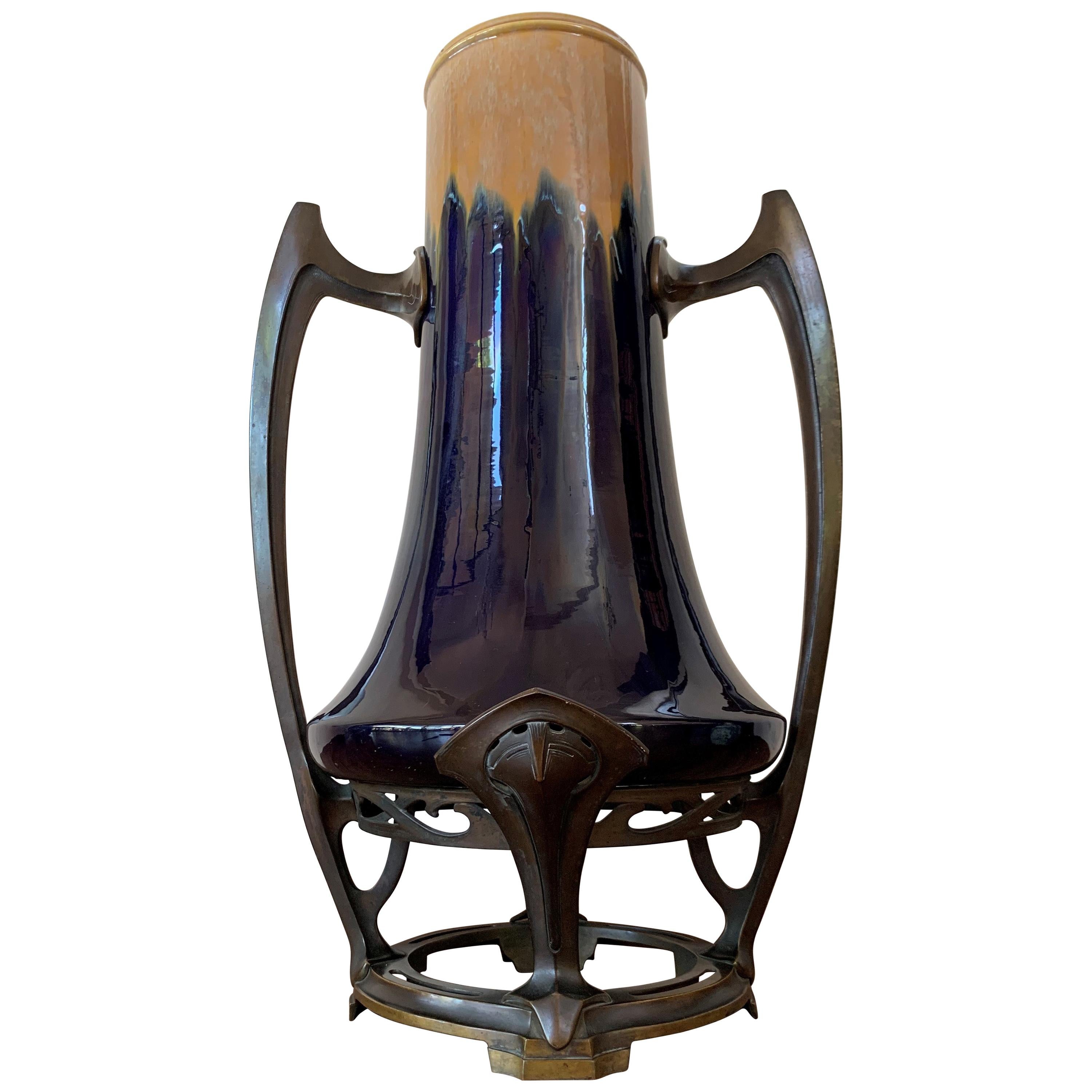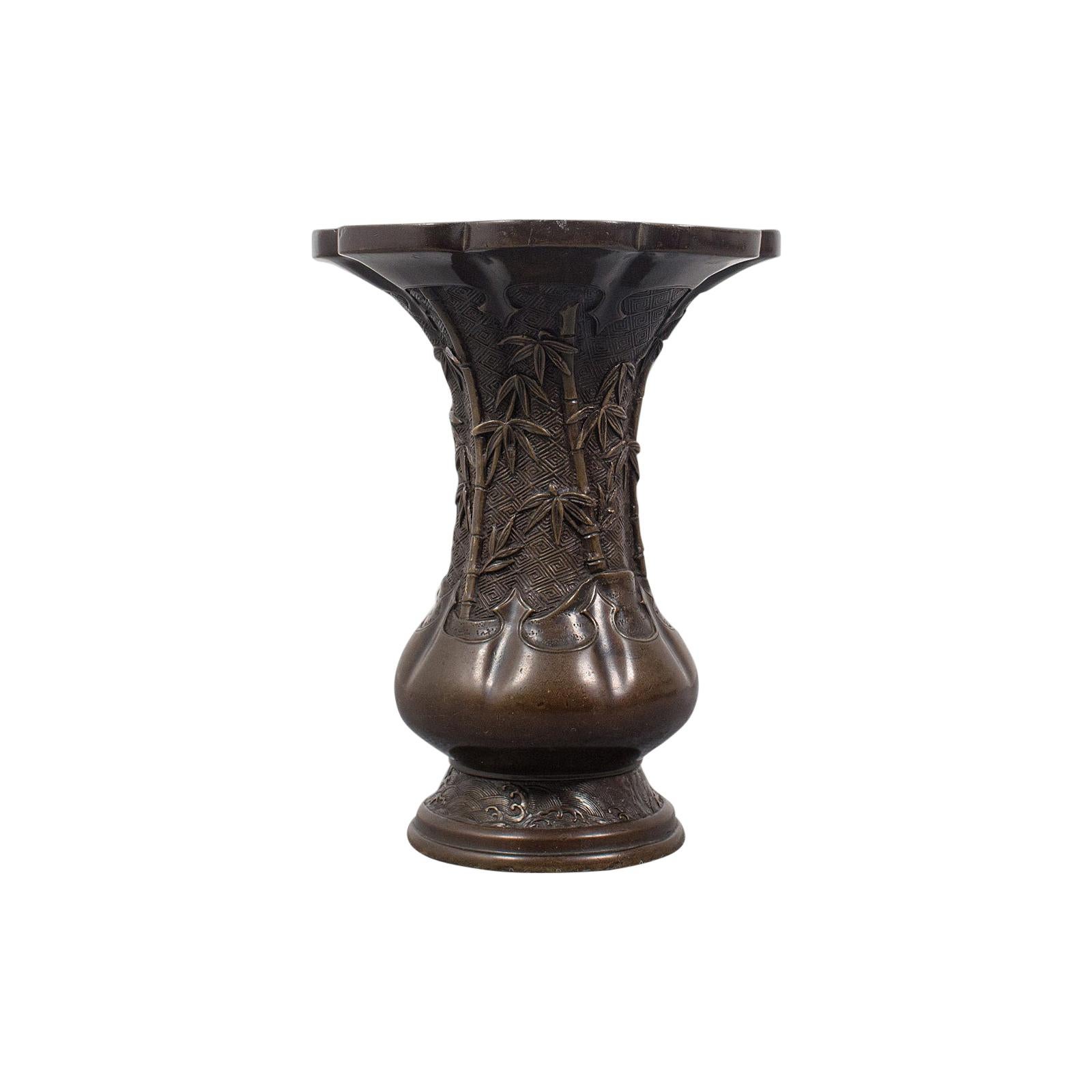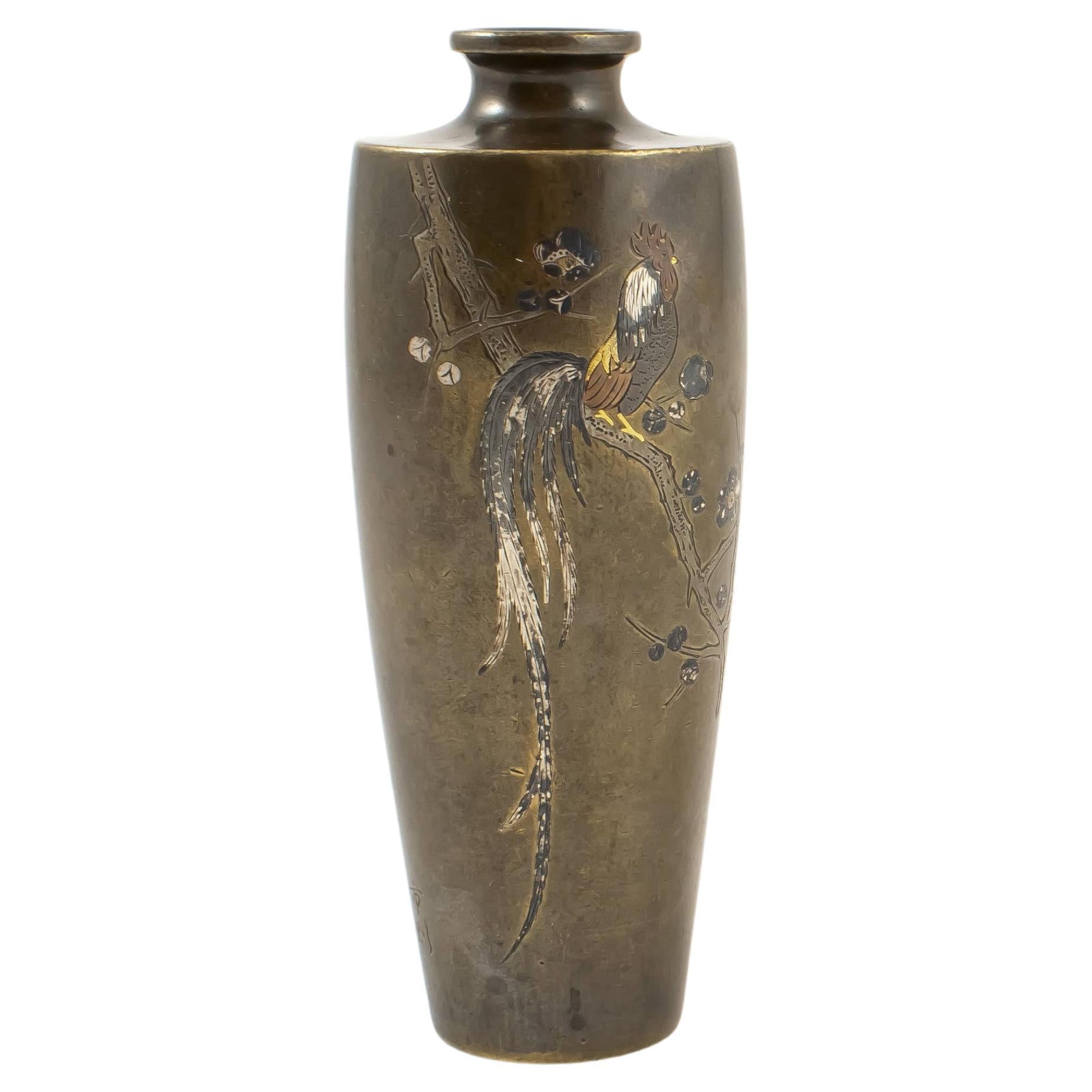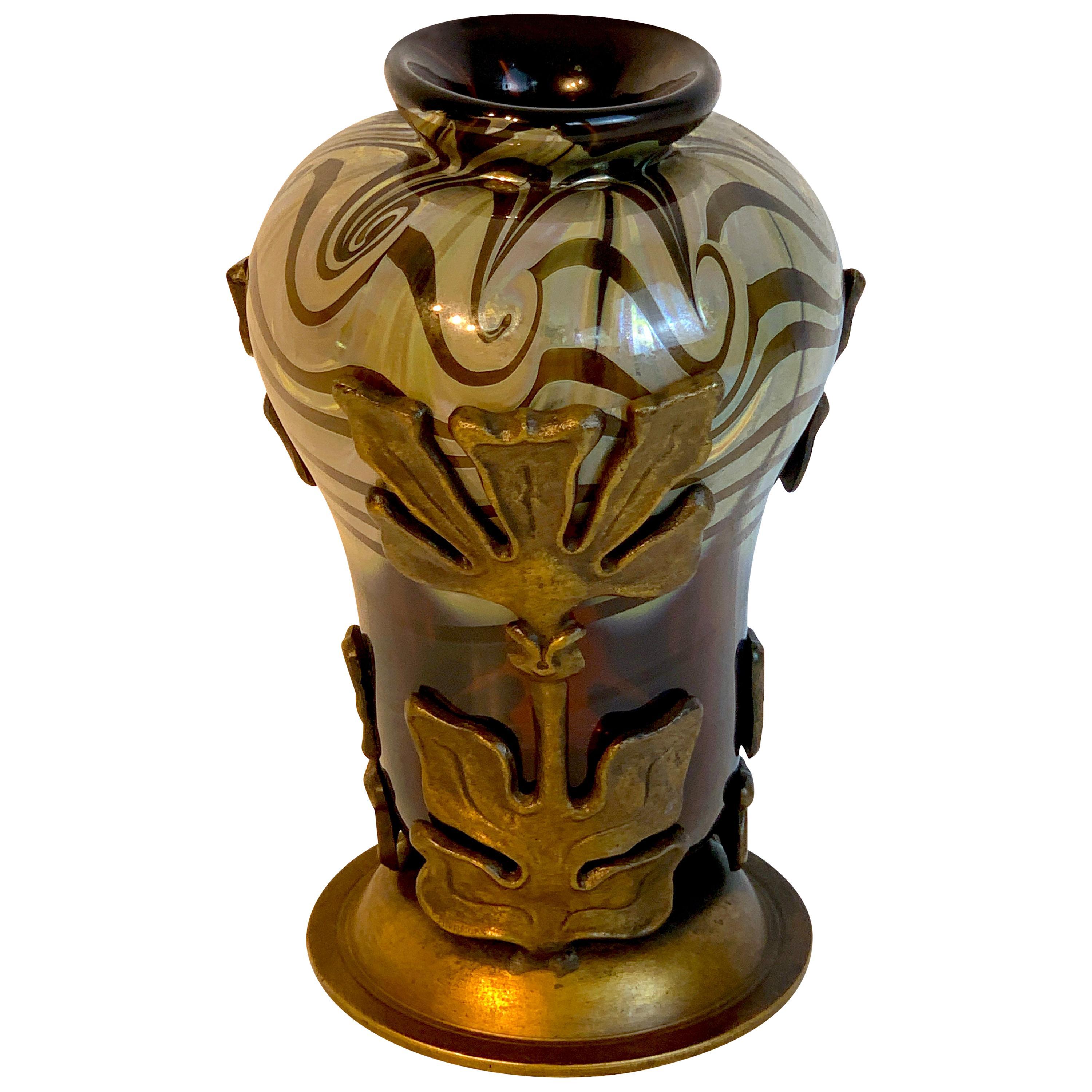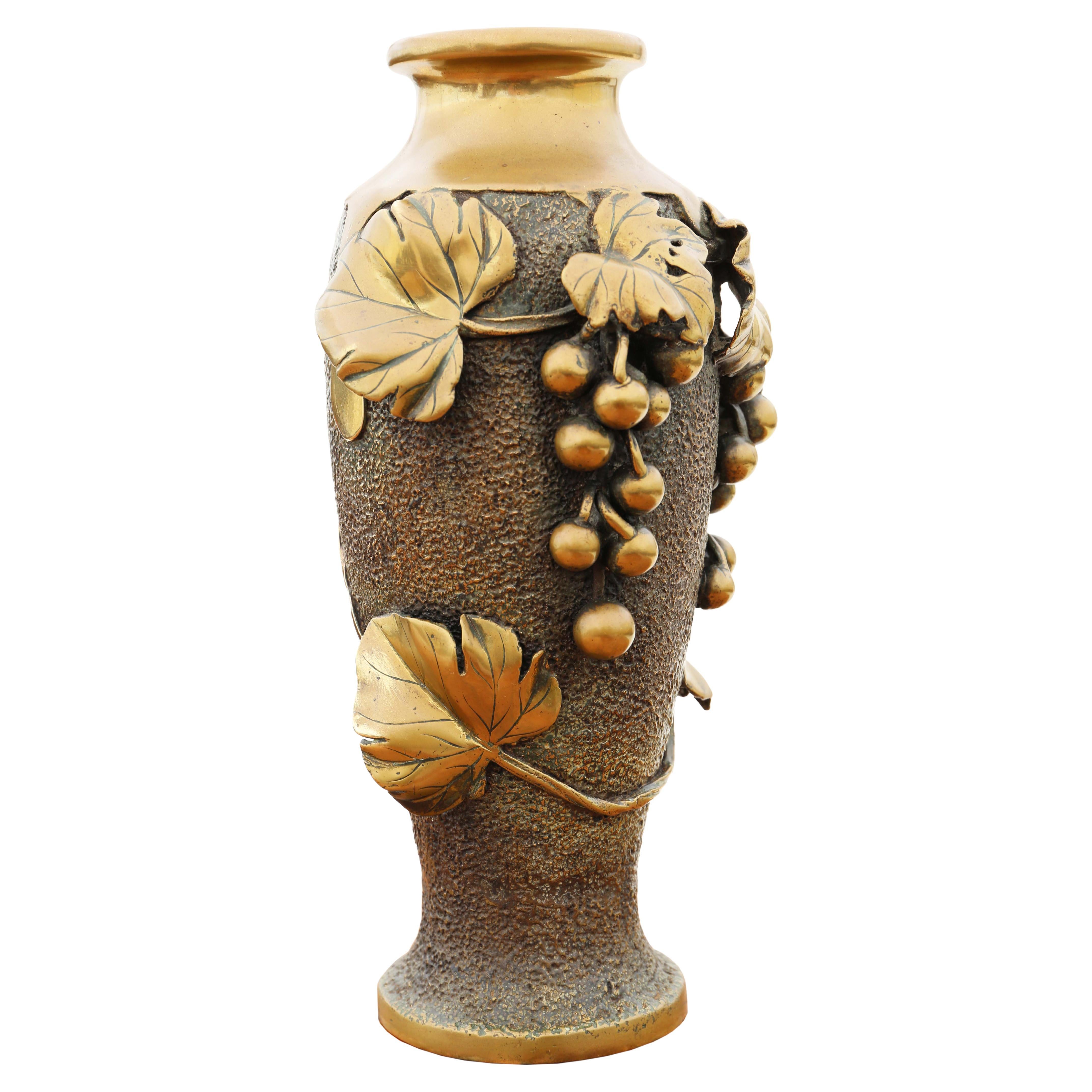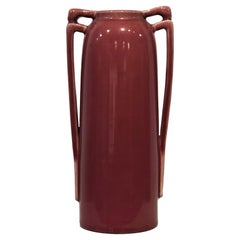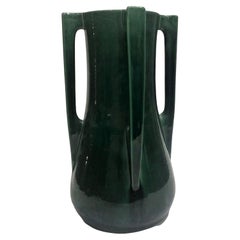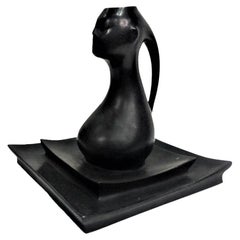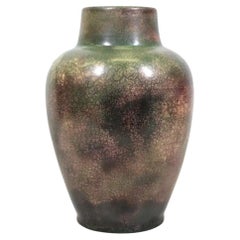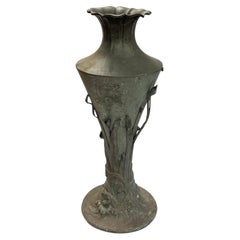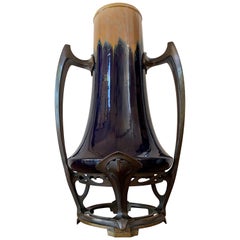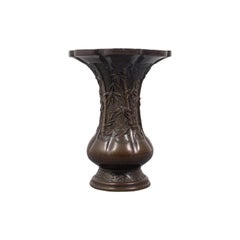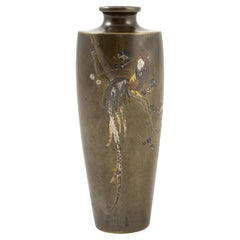Items Similar to Japanese Art Nouveau Meiji Period Patinated Bronze Vase, circa 1900
Want more images or videos?
Request additional images or videos from the seller
1 of 10
Japanese Art Nouveau Meiji Period Patinated Bronze Vase, circa 1900
$18,000
£13,592.88
€15,562.60
CA$25,420.71
A$27,753.32
CHF 14,549.93
MX$337,074.82
NOK 181,704.97
SEK 171,577.95
DKK 116,158.21
About the Item
Although unmarked, this rare and important, grand but at the same exquisite patinated bronze vase has just a very few little details, defying the shape of the handles, as well as the base, depicting an overturned lotus flower; clearly suggesting the organic motifs being artist’s inspiration.
Purely Japanese in its overall aesthetics and the imaginary simplicity of its form, this amazing work of applied art by an unknown master certainly bears the influence of Europe, which began to manifest itself in the absolutely closed Japanese society at the turn of the 19th and 20th centuries.
Dimensions:
Diameter 18.5 inches
Height 24.75 inches
Handles span 13.75 inches.
- Dimensions:Height: 24.75 in (62.87 cm)Diameter: 18.5 in (46.99 cm)
- Style:Art Nouveau (Of the Period)
- Materials and Techniques:Bronze,Patinated
- Place of Origin:
- Period:1900-1909
- Date of Manufacture:1900
- Condition:Wear consistent with age and use. We make our best effort to provide a fair and descriptive condition report. Please examine the photos attentively. Send us a message to request more details or discuss price.
- Seller Location:New York, NY
- Reference Number:1stDibs: LU2819315719191
About the Seller
5.0
Gold Seller
Premium sellers maintaining a 4.3+ rating and 24-hour response times
Established in 1993
1stDibs seller since 2017
86 sales on 1stDibs
Typical response time: 8 hours
- ShippingRetrieving quote...Shipping from: New York, NY
- Return Policy
Authenticity Guarantee
In the unlikely event there’s an issue with an item’s authenticity, contact us within 1 year for a full refund. DetailsMoney-Back Guarantee
If your item is not as described, is damaged in transit, or does not arrive, contact us within 7 days for a full refund. Details24-Hour Cancellation
You have a 24-hour grace period in which to reconsider your purchase, with no questions asked.Vetted Professional Sellers
Our world-class sellers must adhere to strict standards for service and quality, maintaining the integrity of our listings.Price-Match Guarantee
If you find that a seller listed the same item for a lower price elsewhere, we’ll match it.Trusted Global Delivery
Our best-in-class carrier network provides specialized shipping options worldwide, including custom delivery.More From This Seller
View AllJapanese Art Nouveau Awaji Ware Art Studio Pottery Flower Vase, ca. 1900s
Located in New York, NY
Japanese Art Nouveau
Flower Vase
Awaji Ware Art Studio Pottery
ca. 1900s
ABOUT AWAJI WARE ART STUDIO POTTERY
Awaji pottery was made on the Japanese island of the same name between...
Category
Antique Early 1900s Japanese Art Nouveau Vases
Materials
Pottery
Japanese Art Nouveau, Awaji Ware Art Studio Pottery Flower Vase, Ca. 1900
By Awaji Pottery
Located in New York, NY
DIMENSIONS:
Height: 12.5 inches
Width: 6.75 inches
Depth: 6.75 inches
ABOUT AWAJI POTTERY
Awaji pottery was made on the Japanese island of the same name between 1830 and 19...
Category
Antique Early 1900s Japanese Art Nouveau Vases
Materials
Ceramic
Alfonso Canciani, Viennese Secession Orientalist Bronze Vase, c. 1910
By Alfonso Canciani
Located in New York, NY
Alfonso Canciani (Italian-Austrian, 1863-1955) was a famous Italian-Austrian sculptor of the period of accession to the Viennese Secession. Son of a stonemason, after a realist period he managed to establish himself as a leading sculptor of the Viennese Secession. In fact, he worked in Vienna, where he had enrolled in 1886 at the Academy of Fine Arts, then at the Higher School of Sculpture and finally at the Special School, where he obtained the Rome prize for the sketch for Dante's Monument.
He developed a notable business obtaining important prizes and numerous commissions. First among the sculptors of the Viennese capital, he was invited to join the Association of the Viennese Secession, of which Klimt was magna pars, after the exhibition of Dante's group in 1900 at the Secession exhibition, and obtained the most important Austrian artistic prize, the Kunstlerlpreis.
This same work, presented in 1910 in Berlin, at the Great Art Exhibition, also received an important recognition here. He obtained the Rome prize in 1896, exhibited successfully in Munich and in 1899 at the III International Art Exhibition in Venice.
In that period he made some statues of saints for the cathedral of Santo Stefano in Vienna, the monument to Wagner, the bust of Nietzsche for the University, the scepter and the gold chain of the University Rector, figures of Italian poets ( Petrarch, Boccaccio, Tasso, Ariosto).
He submitted a sketch for the official monument to Empress Elizabeth, which was then built in Austrisn Gföhl and Pula. At the time of his accession to the Secession, he dedicated himself to decorating the facade of the Artaria house in Vienna in collaboration with the architect Max Fabiani.
He later abandoned the symbolist decorativism of the Jugendstil for a more concentrated and vigorous style, approaching the Belgian sculptor Constantin Meunier for the theme of work, and preferring to exhibit at the Künstlerhaus.
In Vienna, he was generous with advice and help with the Italians and in particular with his fellow citizens (such as the Brazzanese Luigi Visintin, then a university student).
After the First World War, he returned to Italy and lived in Friuli, penalized by the fact that the Habsburg Empire had by now disappeared. Instead of large-scale public monuments, he then devoted himself to engraving medals (e.g. for Benedict XV and for the Italian mission in Vienna in 1919) and to designing funeral monuments (examples in Mali Lošinj and Trieste) and portrait busts (of Generals Carlo Caneva and Antonio Baldissera in Udine, sculptures of the War Memorial of Corno di Rosazzo). After all, he had already executed the Bab grave monument in the Döblinger cemetery in Vienna in 1909.
He taught in Trieste from 1920 until 1935, at the local school of industrial art, where he had Marcello Mascherini...
Category
Vintage 1910s Austrian Jugendstil Vases
Materials
Bronze
Arts & Crafts Chinese-Form Ceramic Vase, ca. 1900
By Roseville Pottery
Located in New York, NY
American Arts & Crafts
Chinese-Form Pauleo Pattern Glazed Ceramic Vase
In Manner of Roseville for Tiffany
Circa 1900
DIMENSIONS
Height: 15.75 inches (40.01 cm)
Diameter: 10.5 inch...
Category
Antique Early 1900s American Art Nouveau Vases
Materials
Ceramic
French Beaux Arts, Patinated Bronze Figural Vase by A. Bofill, Ca. 1900
By Antoine Bofill
Located in New York, NY
Antoine Bofill (Spanish-French, 1875-1925) was a Spanish artist and member of the Animalier movement of the 19th century. Best known for his small, decorative bronze sculptures, Bofi...
Category
Antique Early 1900s French Beaux Arts Vases
Materials
Bronze
Japanese Meiji Era Bronze Lotus Leaf Bowl, Vide Poche, ca. 1900
Located in New York, NY
DIMENSIONS: Height: 4 inches Width: 6 inches Depth: 6 inches
ABOUT THE OBJECT
With the laconic Japanese-style Art Nouveau design, filled with symbolism and metaphorism, this multi-use bowl...
Category
Antique Early 1900s Japanese Art Nouveau Vases
Materials
Bronze
You May Also Like
Large Japanese Antique Art Nouveau Period Bronze Garden Vase
Located in New York, NY
Very large antique (late 19th century) Art Nouveau period garden vase with reeds and flowers emanating from rolling waves of water that decorate the base, with separately cast and ap...
Category
Antique Late 19th Century Japanese Art Nouveau Vases
Materials
Bronze
Art Nouveau Water Lily Vase Jugendstil Bronze in the Manner of Otto Eckman
By Otto Eckmann
Located in Miami, FL
Jugendstil ceramic vase bronze mounted is an original decorative object realized in the early 20th century.
Original ceramic vase with cream and cobalt blue glaze. All around colorf...
Category
Antique Early 19th Century German Jugendstil Vases
Materials
Bronze
Antique Oriental Vase, Chinese, Bronze, Decorative Baluster Urn, Victorian, 1900
Located in Hele, Devon, GB
This is an antique Oriental vase. A Chinese, bronze decorative baluster urn, dating to the late Victorian period, circa 1900.
Superb decorativ...
Category
Antique Late 19th Century Chinese Late Victorian Vases
Materials
Bronze
Japanese Shakudo Bronze Vase Meiji Period
Located in Kastrup, DK
apanese Shakudo bronze vase, Art Nouveau.
From Nogawa workshop, seal marked at the bottom approx. 1890.
With pheasant on branch and flowers, inlaid with silver enamel and 24 cara...
Category
Antique Late 19th Century Japanese Art Nouveau Vases
Materials
Gold, Silver, Bronze, Enamel
Art Nouveau Bronze Mounted Loetz Vase, Stamped Made in Austria
By Loetz Glass
Located in West Palm Beach, FL
Art Nouveau bronze mounted Loetz vase, stamped made in Austria', in two parts the vase with beautiful pulled feather decoration. The bronze frame with stylized floral design, stamped...
Category
Early 20th Century Austrian Art Nouveau Vases
Materials
Bronze
$1,200 Sale Price
20% Off
Antique Fine Quality Japanese Meiji Period Bronze Vase circa 1910 Art Nouveau
Located in Wisbech, Cambridgeshire
Antique fine quality Japanese Meiji period bronze vase C1910 Art Nouveau. Decorated with grapes and vines.
Would look amazing in the right location. The very best colour and patin...
Category
Early 20th Century Vases
Materials
Bronze
$1,248 Sale Price
30% Off
More Ways To Browse
Patinated Bronze Vase
Meiji Period Vase
Japan 1900
19th Century Japanese Bronze Vases
Japanese Bronze Vessel
Meiji Bronze Vase
Art Nouveau Vase Gold
Art Nouveau Vase Bronze
Japanese Meiji Bronze Vessel
Japanese Art Nouveau
1900 Japanese Vase
Japanese Patinated Bronze Vase
Circa 1900 Japanese Vase
Japanese Art Nouveau Bronze
Hand Blown Glass Vase Collections
Vases Glass Blown Black Modern
Chinese Porcelain Vase 19th Century
Antique Luster
